May 6, 2021
Puffin Watching Tours on Lunga Island from Oban or Mull in Scotland
Active life, Biology, Bird-watching, Conservation, Experience, Fauna, Tour, Travel
Top attractions:
Puffins at the Edge of Scotland
When it comes to travel planning, one of my favorite things to do is to keep looking at the map, searching for remote places, and wondering how is it like over there? Maybe it is just out of pure curiosity, or maybe I just like to test my imagination, either way, I start to dream of visiting the actual place and seeing it with my own eyes. The Inner Hebrides of Scottish Highlands is one of those places, and within it lies small Treshnish isles. Once I looked at the map of the United Kingdom, I couldn’t help myself, but wonder, what is over those islands scattered around the western coast of Scotland. Luckily for me, this is also one of those places which I got to visit.
It appears that the Treshnish Isles probably has more inhabitants than London. These tiny islands on the corner of Scotland are populated by colonies of countless birds of different species. The most famous among them is, of course, the charismatic puffins. If the Treshnish Isles are their country, then Lunga Island is their Capital, and Staffa Island – a popular resort in the overseas territories. Luckily, puffins and their co-inhabitants are friendly to us – humans, or at least the birds don’t mind our company. Therefore, visiting Lunga Island on a puffin-watching tour is a pure joy to our eyes and our souls.

The charismatic puffins on Lunga island, Scotland. Photo by Alis Monte [CC BY-SA 4.0], via Connecting the Dots
Oban Puffin Tours Details
- Difficulty: Easy to Uncomfortable, depending on the Scottish weather
- Duration: 10h15 (9h50- 8h05)
- Starting Point: Oban or Ulva Ferry (Isle of Mull)
- Destination: Staffa and Lunga Islands, Treshnish Isles
- Tours: Calmac & Turus Mara or StaffaTours
- Price: £70 (From Oban)
- Best time to visit: May-July
- Accomondation: Oban & Craignure
- Weather: Oban forecast & Isle of Mull
Map of Oban Tours

Hard to see anything from this distance without binoculars, eh? Photo by Alis Monte [CC BY-SA 4.0], via Connecting the Dots
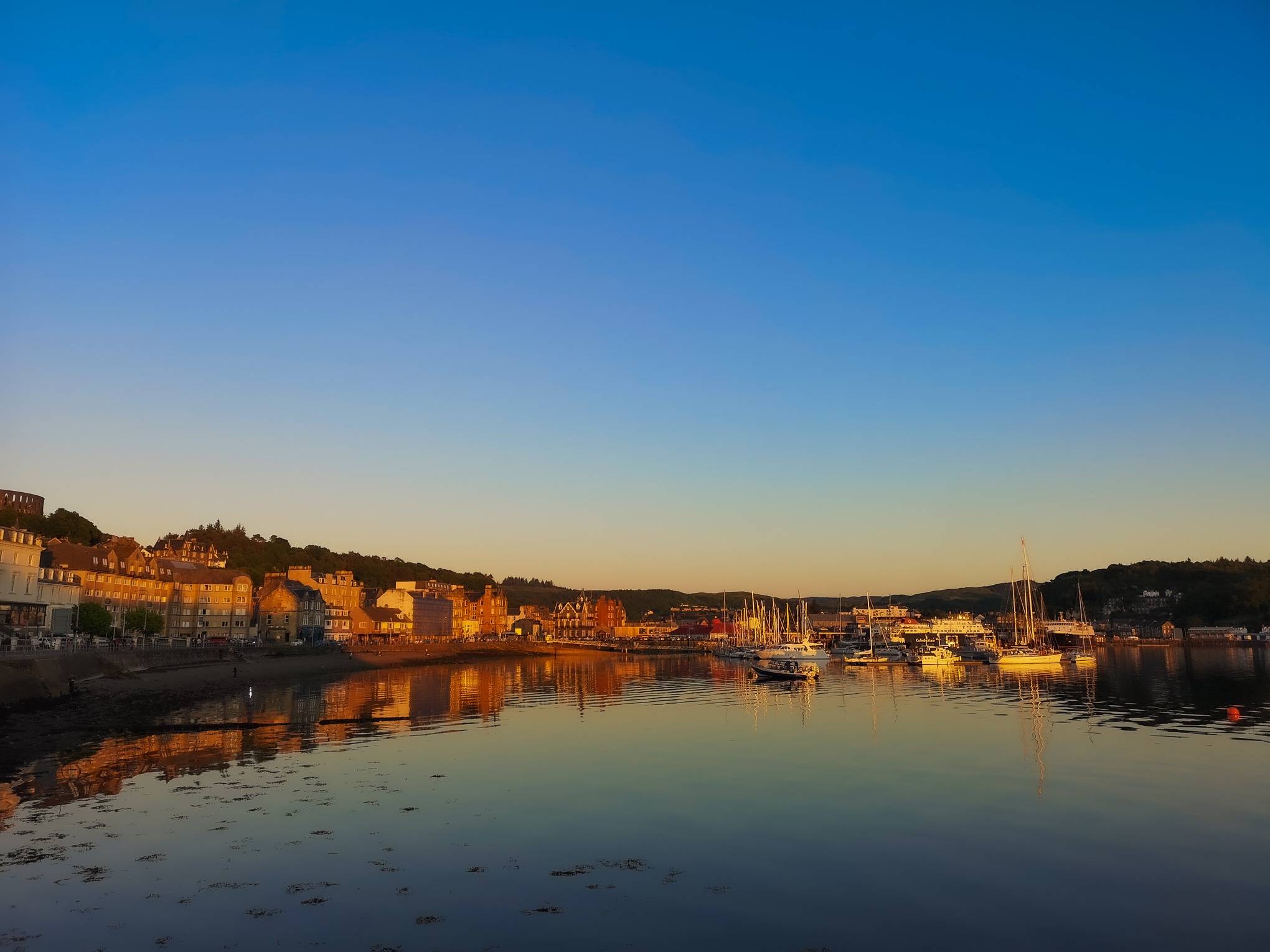
Oban port town – The fishing capital of Scotland. Photo by Alis Monte [CC BY-SA 4.0], via Connecting the Dots
How to get to Oban, Scotland
By bus
Though on the edge of Scotland, Oban is a popular tourist destination, therefore, it is well connected with most of the major cities in the country. You can find your route on city link website.
Pro tip: Traveling through Scotland could be pretty expensive. If you are planning to travel by bus, buying CityLink’s Explorer Pass could be a good idea. Just have in mind that buses first will board people with tickets in advance. More information.
By Train
Oban can be also reached by train via The West Highland Line from Glasgow. See the timetables.
By car – A82
In spite of the direction you are coming from, it is probably best to approach Oban via A82 connecting Glasgow to Inverness via Fort William. Just be sure not to miss the turn to road A828 in North Ballachulish.
Pro tip: Scotland is a vast and beautiful place, but once you start traveling toward the North it is not as populated as the South. Some of the roads could be quite challenging for a less experienced driver. Therefore, if you don’t have a lot of confidence in your driving skills – especially if you don’t have any experience driving on the left side of the road – the local drivers will appreciate it if you choose another method to travel across the northern part of Scotland.
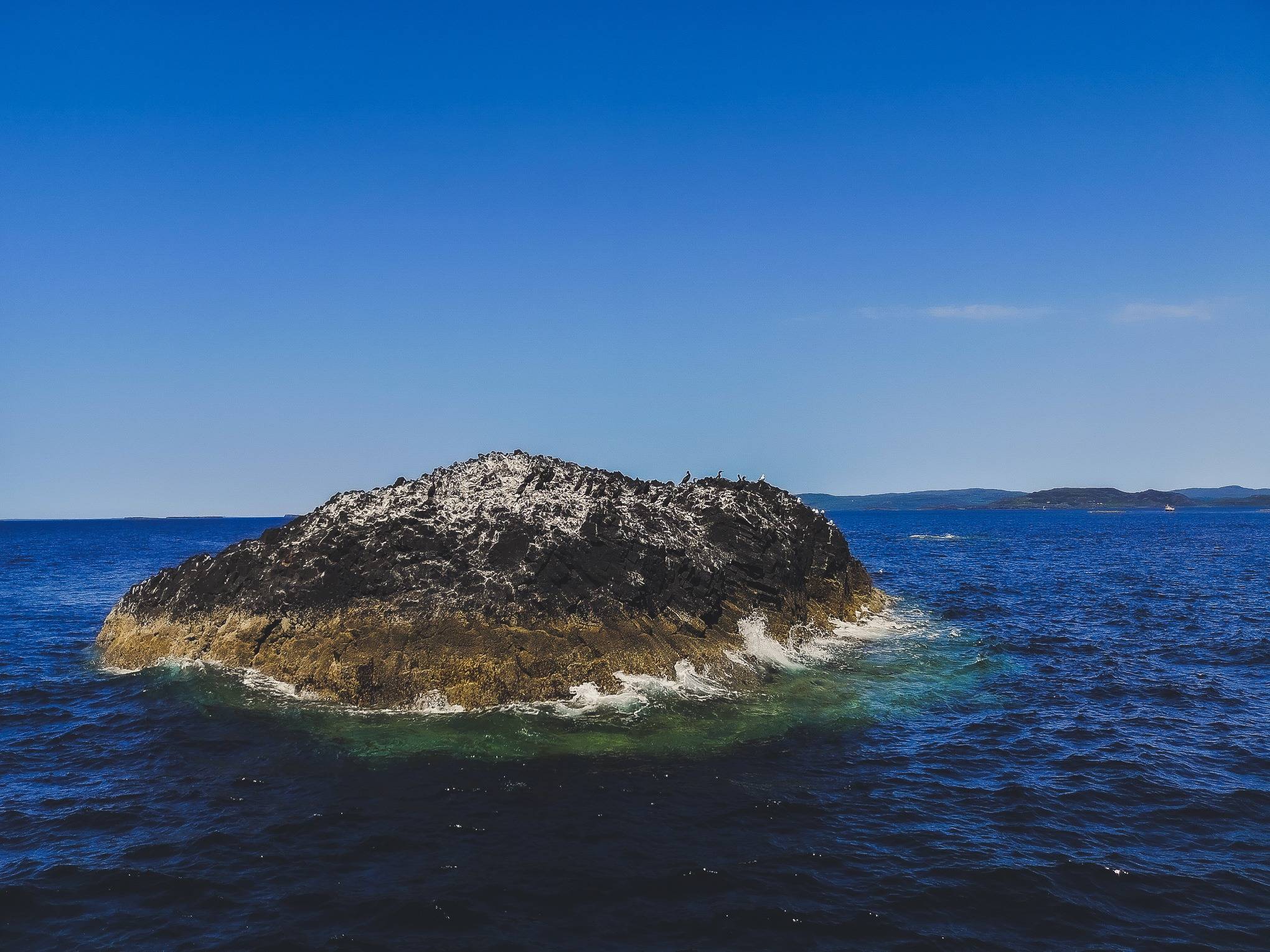
Birds on an islet of the Treshnish Isles, Inner Hebrides, Scotland. Photo by Alis Monte [CC BY-SA 4.0], via Connecting the Dots
Visiting Puffins on Lunga Island Travel Guide
I know, there are a lot of different location names in this article, but they all fall under Hen Ogledd (the “Old North”). The precision is here only to help those who actually want to do Staffa Island & Treshnish Isles Wildlife tour, a.k.a. Puffin therapy tour. Hopefully, after you’ll finish reading this, these random names will have more meaning to you. …so, where are these islands?
Everybody probably heard of The Highlands of Scotland. While it is a separate region, the population of it is scarce. Naturally, Highland sometimes is grouped with the Islands to form one bigger region. Argyll and Bute are one of the non-highland island regions. This is where we find Oban Town, which is actually Scotland’s fishing capital. The Inner Hebrides are a group of islands belonging to Argyll and Bute. They are located around Oban.
Treshnish Isles are located within the Inner Hebrides, just to the West of the large Isle of Mull. Lunga is one of the Treshnish Isles. In fact, Lunga is the biggest Island of all Treshnish Isles, and Staffa Island is between Treshnish Isles and the Isle of Mull. This tiny corner of Scotland is where countless bird species find it as their home.

The Treshnish Isles wildlife tour ships near a shore of Lunga island, Scotland. Photo by Alis Monte [CC BY-SA 4.0], via Connecting the Dots
Best Puffin Tours
When it comes to tour choices, there are not as many tours as to other parts of the Highlands, namely Skye Island. On the other hand, this makes picking one easier. My personal choice was to go with Calmac & Turus Mara because we expected to see more of the isles and beautiful rock formations going from Ulva ferry, but I would bet that StaffaTours are just as good if not better to some people.
This company will take you to the Treshnish isles from Fionnphort. I expect it to give a totally different angle of Isle of Mull and smaller Isles, also a possibility to see Iona Island from nearby.
If your main goal is to visit Staffa Island and the iconic Fingal’s Cave, there are even more options. but this article will focus on the Treshnish isles wildlife tour – you got to see those puffins. If it does look like too much of trouble, you can always pick all-included guided tour to the area from either Edinburgh or Glasgow.
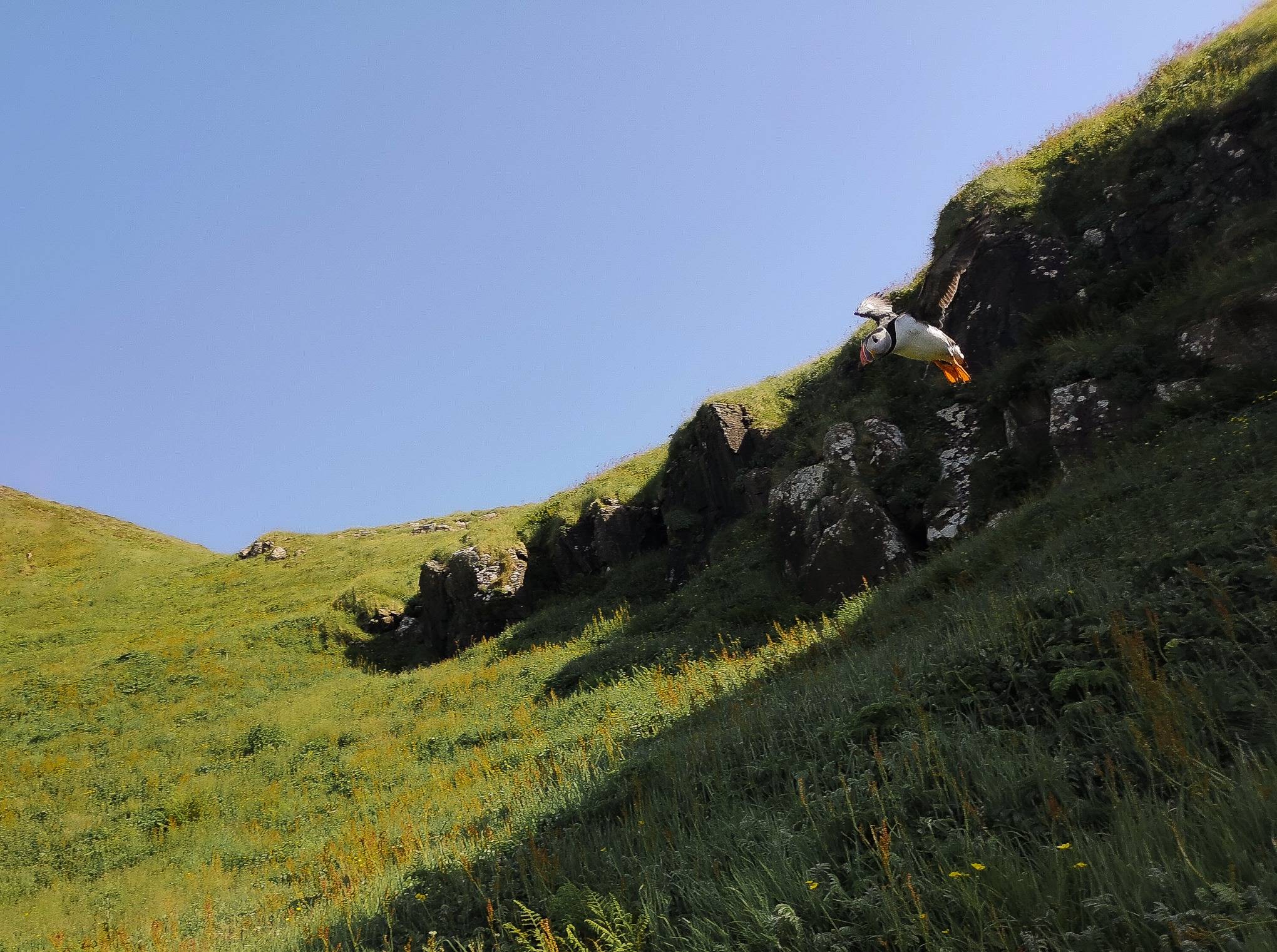
Flying puffin in Lunga Island, the Treshnish Isles wildlife tour, Scotland. Photo by Alis Monte [CC BY-SA 4.0], via Connecting the Dots
Tour Facilities
The first 45minutes starts on a big ferry from Oban to Craignure in the Isle of Mull. It is operated by Calman ( Caledonian MacBrayne). Any facility that could be expected from a ferry is there, including a restaurant, café, bar, souvenir shop, bathroom, plenty of spaces to sit, and some drunk British people, going for their holiday in the Isle of Mull.
Inside Turus Mara ship, which you’ll board at Ulva ferry, there is a possibility to charge your devices, use a bathroom, buy water, tea, coffee, and even a puffin therapy mug.
There is nothing similar to civilization found either on the Treshnish Isles or Staffa Island, not even to mention a bathroom or a source of drinkable water. Prepare in advance!

Isle of Mull, Argyll and Bute, Scotland. Photo by Alis Monte [CC BY-SA 4.0], via Connecting the Dots
The Itinerary of CalMac & Turus Mara Puffin Tour
Turus Mara bus from Craignure to Ulva ferry is basically a taxi. If you expect to see the Isle of Mull, you are on the wrong tour. The minibus bus will zip through the island from Craignure straight to Ulva Ferry just in 30 minutes. Meanwhile, expect to be told some things about the Isles visible from the road. Each one of them feels like a mini version of Scotland, having some mountains, cliffs, trees, and the idyllic sheep grazing the fields.
Once the driver gets you to the spot, you most likely going to meet some more people joining the tour. The Isle of Mull is a popular tourist destination, thus many people come directly to the Ulva ferry. There is no public transport, which could bring you to the spot, therefore you need a car for that.
After boarding Turus Mara ship is where the magic of the day starts. The next 6 hours you’ll spend out at the sea by the islands, but more about that later. Once the cruise tour is over, you’ll be brought back to Oban the same you were brought here. If you want to read more about the itinerary of the tour, visit the official page.
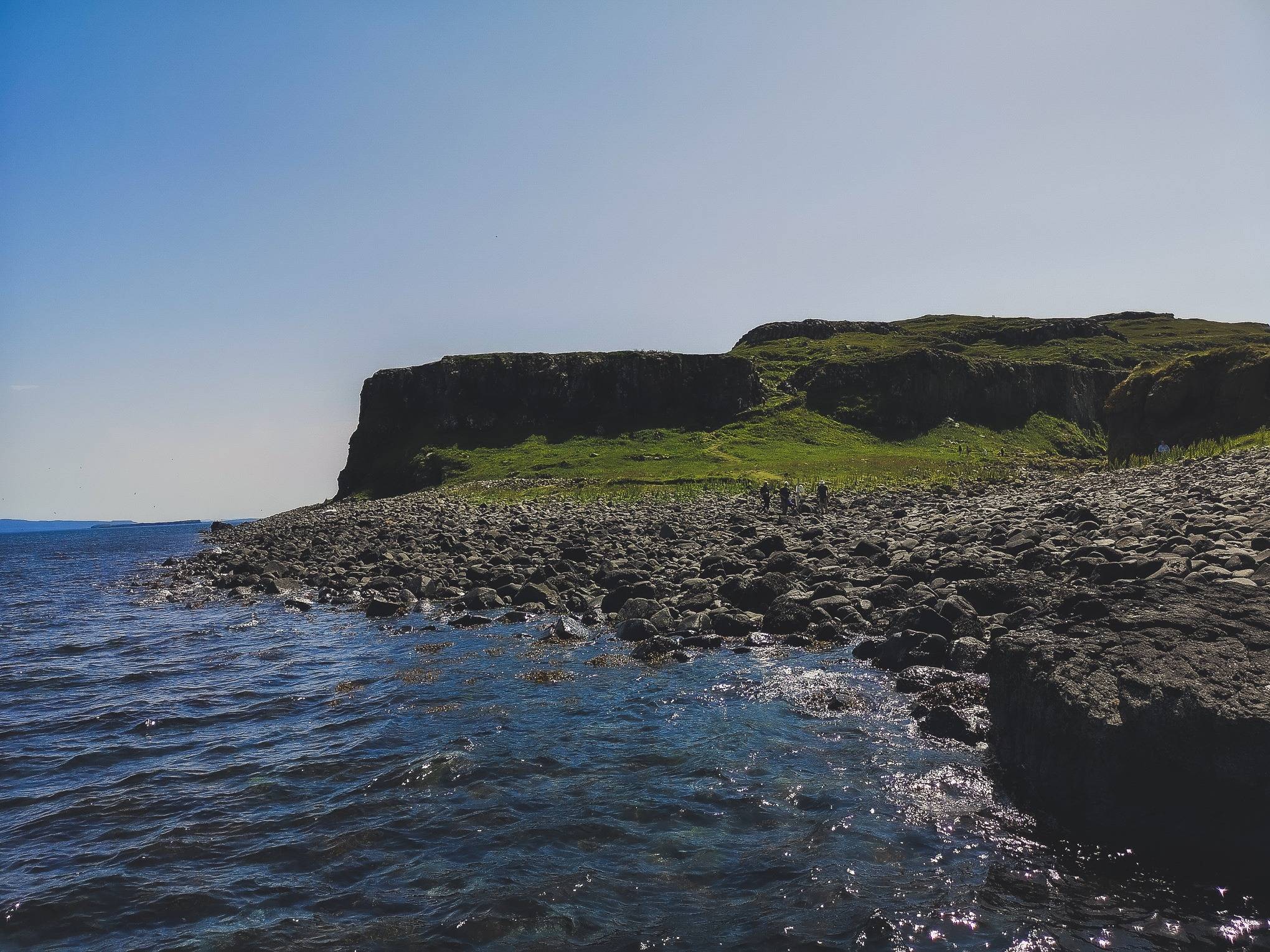
Disembarking the ship to Lunga Island, the Treshnish Isles wildfire tour, Scotland. Photo by Alis Monte [CC BY-SA 4.0], via Connecting the Dots
Is it Difficult to Walk in Staffa & Treshnish Isles?
I wish I could say that it is not difficult to hike around Staffa or Lunga islands, but in reality, it depends on the weather conditions and preparation. I’ve seen old people walking the walk, but I also saw really old people not doing it. First, if the weather is nice – expect a simple hike by the cliffs, washed by sea waves. Second, if it’s rainy – you’ll have to watch your steps because the rocks will be slippery. Finally, if the weather is not that nice, it’s windy and the waves are high – I doubt the ship will dock by the shore of Staffa Island. In that case, there will be no need to worry about the difficulties walking around the island could cause.

Hexagon shore of Staffa Island, during the Treshnish Isles wildlife tour, Scotland. Photo by Alis Monte [CC BY-SA 4.0], via Connecting the Dots
About Staffa Island
The meaning of the island is pretty obvious to those who spent their share playing computer games, to those who didn’t – the word Staffa originated from Old Norse stafi-oy (stave or pillar). If you somehow haven’t seen a single picture of the island, and you don’t understand what staff could actually have to do with the name of the island, the answer is pretty simple. The East rock face of Staffa looks like it was built from pillars. NO, Vikings didn’t build it. They were just as surprised as we are today. Staffa island resembled them of their homes, which were built from vertical trees. Maybe, homesickness, eh? Nevertheless, to everybody’s amazement (unless you are a geologist), the amazing rock formations of Staffa Island are of natural origins.
Even though Staffa Island is a part of the tour, it is so spectacular that it needs a separate article to cover everything this natural wonder has to offer. Read the detailed guide to the history and geological formations of Staffa Island and Fingal’s Cave.
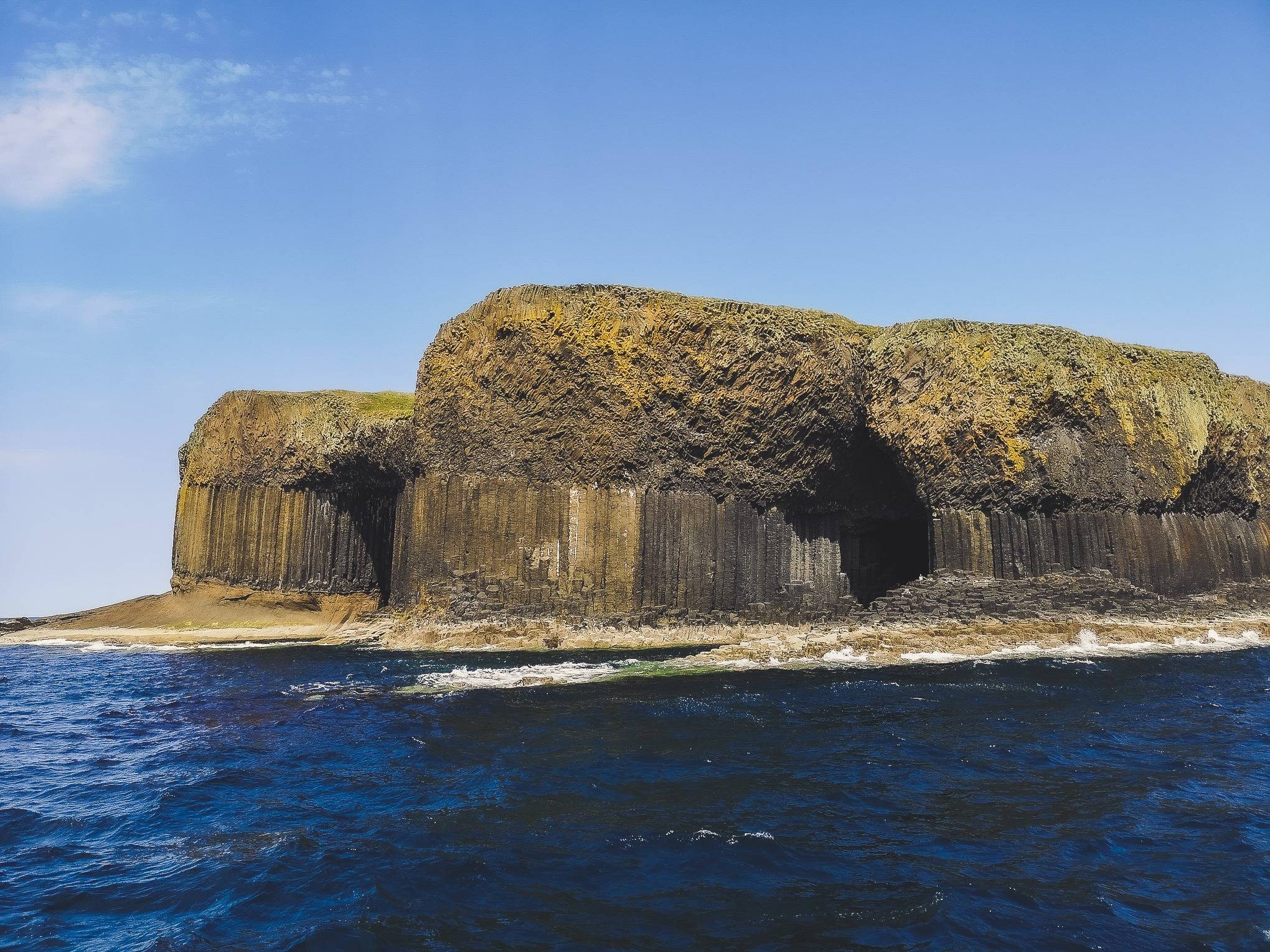
Staffa and the Treshnish Isles wildlife cruise tour, Scotland. Photo by Alis Monte [CC BY-SA 4.0], via Connecting the Dots
About Treshnish Isles
For ages, the Treshnish Isles were playing with the imagination of inhabitants of the Isle of Mull. Dark shapes of the isles gained the title of a fleet of dreadnaughts, indicating the fear of an invasion of the people that used to live here. It was so for a good reason, all coastal territories of Scotland been challenged by the Vikings for several centuries. They even inhabited the Treshnish Isles between the 9th and 13th centuries. For its strategic position, the islands found itself in many wars afterward.
Today, the situation had changed dramatically. It is no longer inhabited by any humans and the fear of invasion was changed by the curiosity of adventurers. Due to its natural beauty and rich biosphere, the islands are a very popular tourist destination in Scotland. For more than a century, nobody has made the Treshnish Isles their home, but many bird species found the isles useful during the breeding season.

The Treshnish Isles wildlife tour from Oban, Scotland. Photo by Alis Monte [CC BY-SA 4.0], via Connecting the Dots
General Rules of Visiting Treshnish Isles
Conservation of this incredible habitat depends on us. The Treshnish Isles are open to everybody, even during the breeding season. It is up to us, visitors, to keep it this way. Please, be conscious of your actions and follow the official rules:
- Take all your litter home.
- Do not disturb or approach the wildlife, particularly during the breeding season.
- Try to sit and wait for a while – it is often possible to gain a more rewarding view of the wildlife.
- Avoid climbing on old walls or moving stones. This can damage a valuable archaeological site.
- Avoid the cliff edges and wet grass on steep slopes.
- Don’t bring dogs (unless assistance dogs) or any pets onto the islands.
You can read more about the conservation of the Treshnish Isles landscape and its wildlife on the official page.

Three puffins and a razorbill on the same rock in Lunga island, Scotland. Photo by Alis Monte [CC BY-SA 4.0], via Connecting the Dots
Wildlife in Treshnish Isles
Without mentioning countless species of birds, the Treshnish Isles is the home to many animals. Most notably- dolphins, including killer whales. Unfortunately, we didn’t see any, but we’ve been told that they usually come to the boat (a common behavior of these majestic animals). Hopefully, you’ll have more luck meeting dolphins. Wherever it was waves that made them hard to spot, or something else, it wasn’t the case for Grey and Common Atlantic Seals. While it is almost guaranteed that you’ll see them chilling on the islets, don’t be surprised by spotting some of them in the open waters.
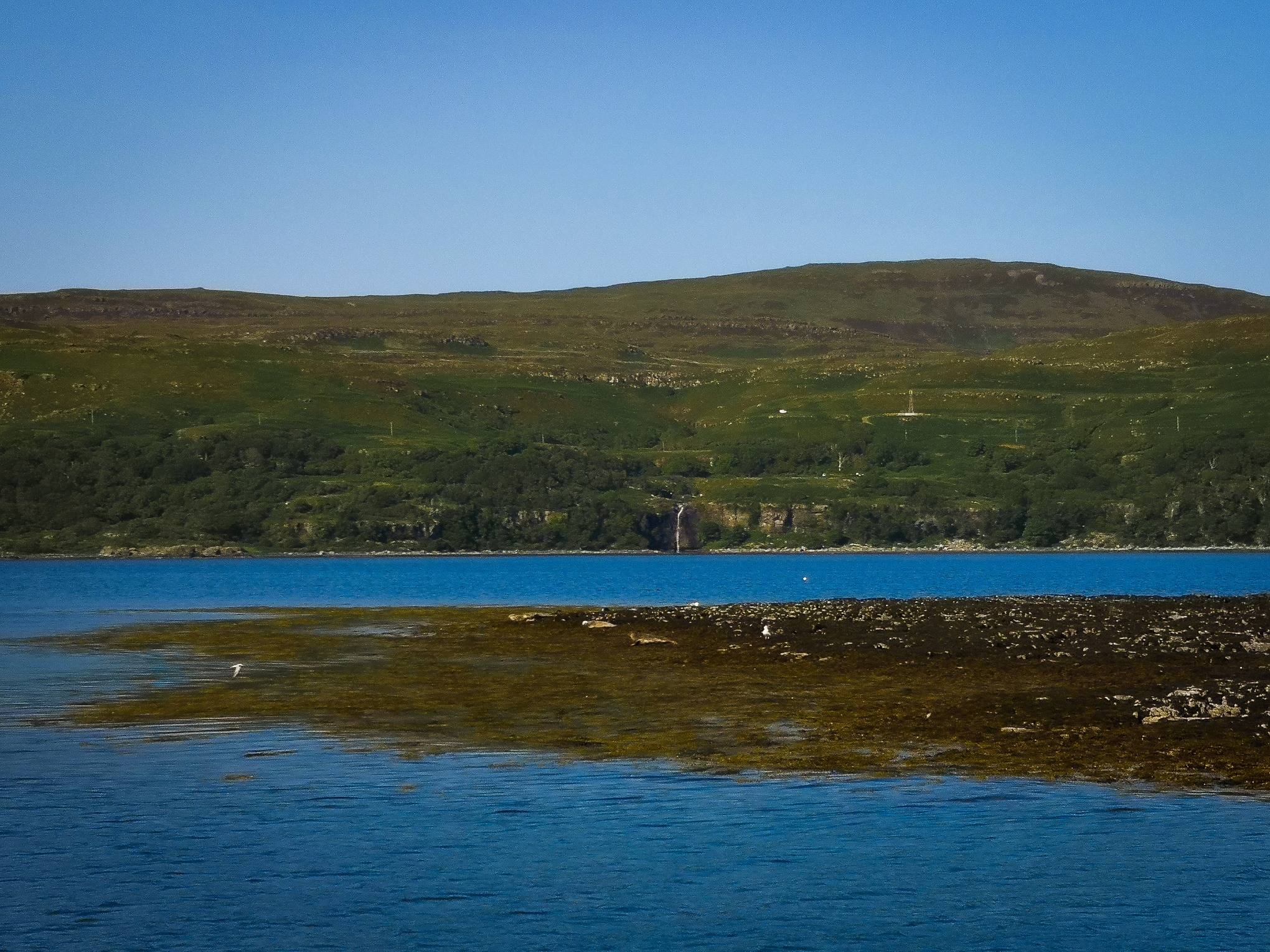
Common Atlantic Seals spotted on an islet during the Treshnish Isles wildlife tour, Scotland. Photo by Alis Monte [CC BY-SA 4.0], via Connecting the Dots
There is also a possibility to meet whales, basking sharks, otters, and lots of other typical wildlife of the Northern Atlantic Ocean. But then again, mammals and fishes are not the reason you are here, the birds are. Be sure to take binoculars with you because they will considerably enhance your bird-watching and dolphin spotting experience.

Puffins Therapy in Treshnish Isles Wildlife Cruise Tour from Oban, Scotland. Photo by Alis Monte [CC BY-SA 4.0], via Connecting the Dots
Puffin Therapy on Lunga Island
Some things just cannot be described. Visiting puffins and their neighbors in Lunga Island is one of those experiences. Once you’ll embark on the shore, you’’ be presented with two options:
- First is a walk to a huge rock which is home to thousands of guillemots (picture a);
- The second being the same, just failing to do so.
It is very easy to get seduced by any of the many puffins living their everyday lives not too far from where you’ll start your journey. I know it is hard, but you need to resist the puffins. There are plenty more of them on the road to the guillemot colony, which is a spectacle on its own.
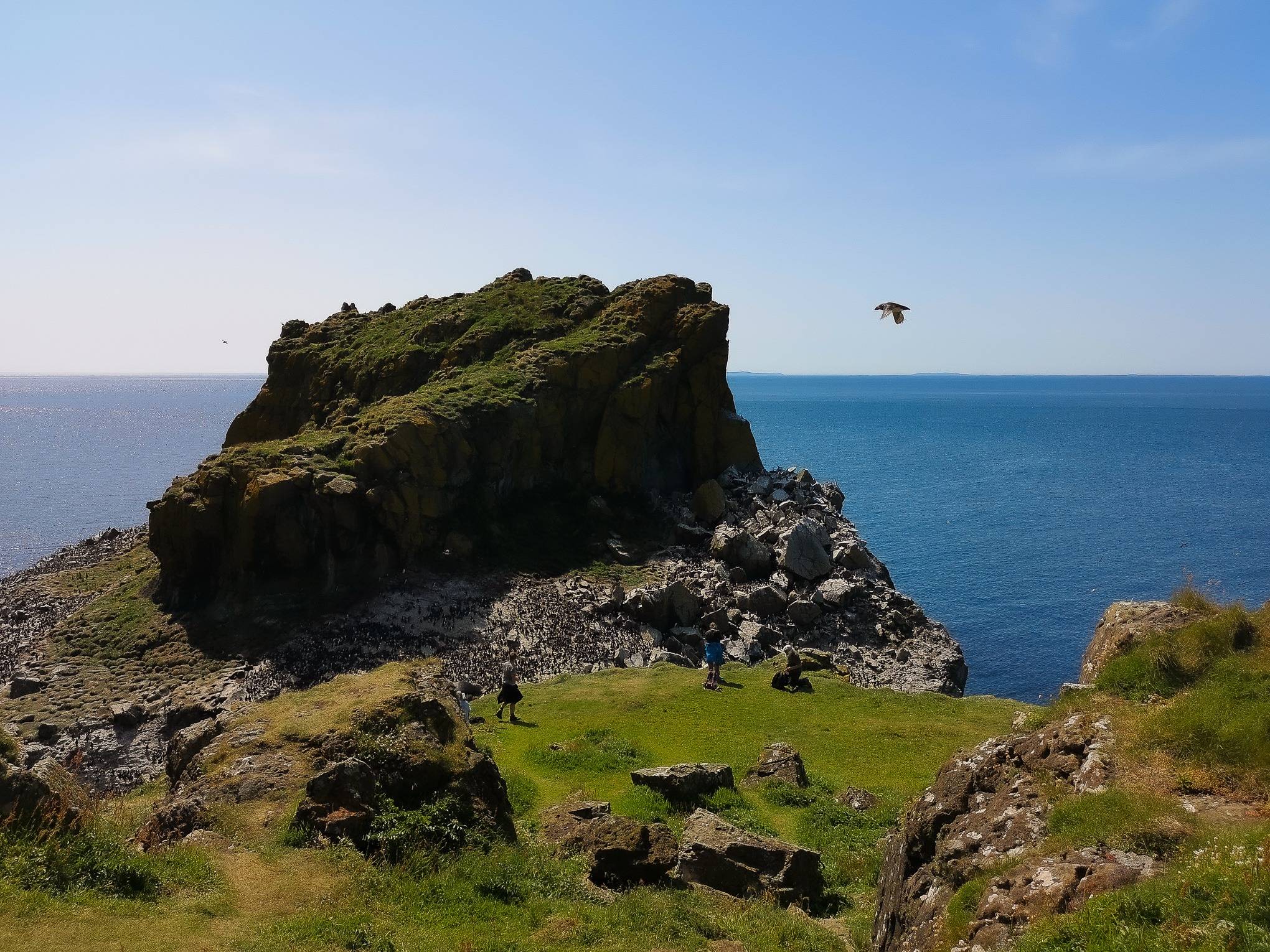
a) Approaching guillemot colony on Lunga Island, the Treshnish Isles wildlife tour, Scotland. Photo by Alis Monte [CC BY-SA 4.0], via Connecting the Dots
The walk will not only reward you with more encounters with birds, but you’ll get the chance to see the beautiful nature of Lunga and the surrounding Treshnish Isles. Surrounded by the charismatic puffins during the whole time in Lunga island – be prepared to smile for a while because these majestic birds will definitely be going to keep you smiling all the time. Be aware, if you don’t like positive emotions – the puffin therapy tour is not for you.

Walking in Lunga island, the Treshnish Isles wildlife tour, Scotland. Photo by Alis Monte [CC BY-SA 4.0], via Connecting the Dots
The wildlife puffin tours to Lunga Island are even advertising themselves as a stress-relief remedy called “Puffin Therapy”. It is hard to describe how, but after the experience, you’ll feel a boom of optimism, The effect is so strong that for a while an ill fortune will seem like an impossible concept. Puffin therapy is a must-try experience!

Two puffins looking at each other, the Treshnish Isles wildlife tour, Scotland. Photo by Alis Monte [CC BY-SA 4.0], via Connecting the Dots
The Magical Puffins
Conservation status: Vulnerable
These little creatures look like they are straight out of a fairy-tale. Due to their similar appearance, they even gained the title of the Atlantic Parrot. People also often mistakenly try to link puffins, or their cousins, to penguins, who only live in the Southern part of the globe. In fact, puffins are as much related to parrots or penguins as any given random chicken. These charismatic birds belong to the Auk family and just as in Lunga Island, are often seen living next door to their cousins: Guillemots and Razorbills. Among whom, they are undoubtedly the cutest ones, and often steal the show.

Razorbills and a puffin on the same rock in Lunga island, Scotland. Photo by Alis Monte [CC BY-SA 4.0], via Connecting the Dots
Puffin’s Colorful Beak
Puffins lose their key feature – the colorful markings of their beaks every autumn and regrow it in spring. They can carry large amounts of fish in their mouth, the current record is somehow 62. Wonder how it is possible? With time the upper part of their beak evolved and grew small spines to hold on to the fish while the tip of their tongue had developed a similar feature to grab the slippery fish and stick it to the spikes above.

Puffin carrying fishes, the Treshnish Isles wildlife tour, Scotland. Photo by Alis Monte [CC BY-SA 4.0], via Connecting the Dots
Conservation of Puffins
While the puffin population in Lunga Island and around is healthy, recently, the rapid decrease of these magical birds in the Shetland Islands, started to raise scientists’ concern. Today, it is ever more important to follow the rules of the park. If you want to help to preserve puffins, you can do so by participating in Project Puffin (which is very simple). Just take pictures of these magnificent birds, while they are carrying food in their mouth, and send them to the authorities. This will help scientists to learn more about their changing diet, which could give an insight into their decline in certain areas. Read more

Two razorbills looking at each other, the Treshnish isles wildlife tour, Scotland. Photo by Alis Monte [CC BY-SA 4.0], via Connecting the Dots
The Curious Razorbills
Conservation status: Near Threatened
The dark horse of the wildlife tour to Lunga Island is Razorbill birds. These close relatives of puffins are easily the most underrated thing of this trip. Overshadowed by the charm of puffins, and the vastness of guillemot colonies, razorbills are nothing less than very interesting and beautiful birds. Not like other birds, razorbills seem to be as interested in you as you are in them. If you want a better shot of any of these birds, I suggest simply sitting and waiting. Razorbills will simply approach you by themselves.
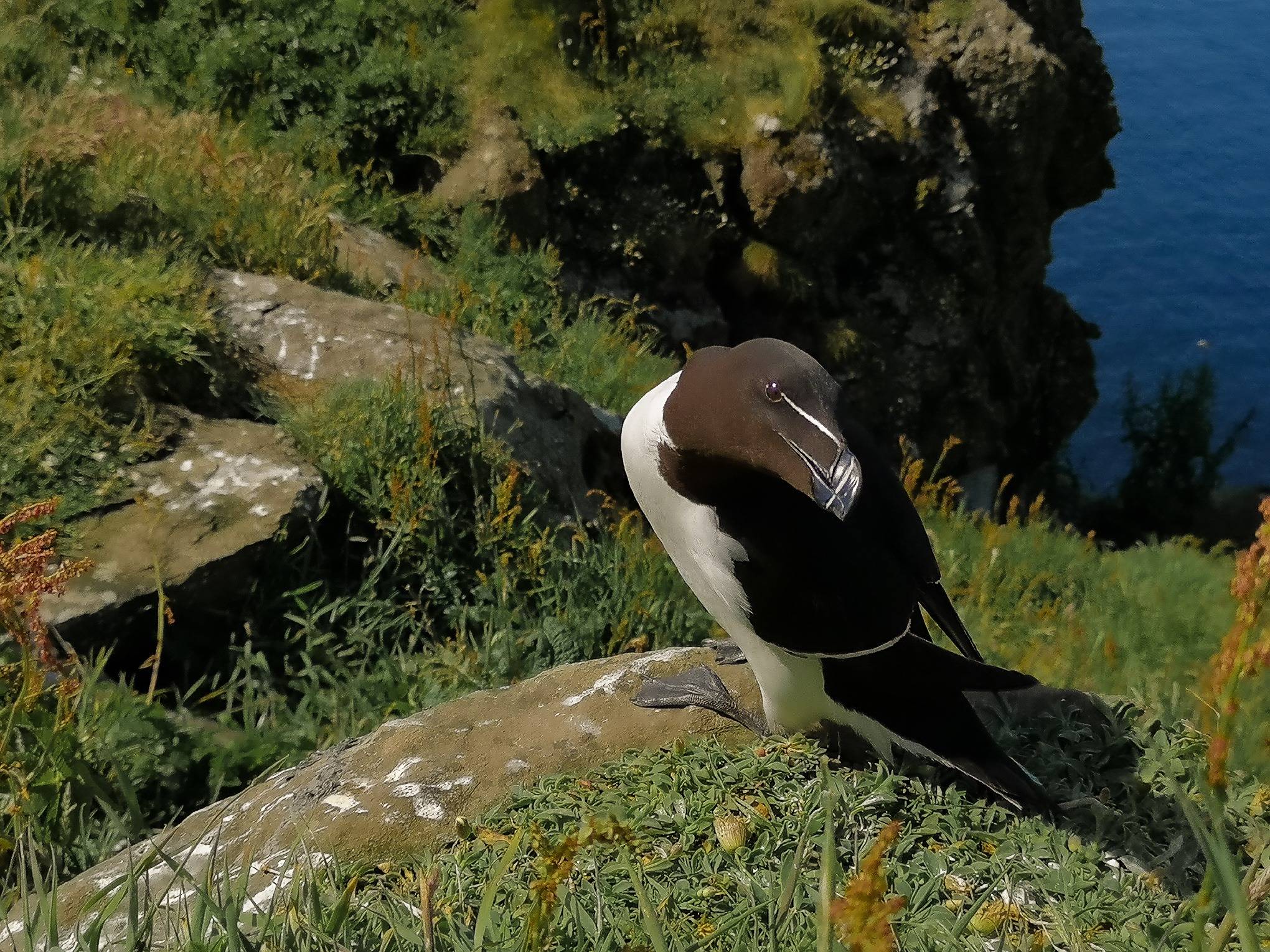
Curious razorbill looking straight at the camera during the Treshnish isles wildlife tour, Scotland. Photo by Alis Monte [CC BY-SA 4.0], via Connecting the Dots
I was quite surprised when one of them landed right next to me, while I was trying to take a shot of a nearby puffin. Just like I caught the attention of the razorbill, he instantly got mine. No matter how much I kept filming or taking pictures of him, the razorbill just kept posing. Though, for most of the time, it looked like his focus was rather on the camera than me. Maybe he saw the thing as the head of the creature staring right back at him.

Razorbill and beautiful female looking at each other during the treshnish isles wildlife tour, Scotland. Photo by Alis Monte [CC BY-SA 4.0], via Connecting the Dots
Razor Bill?
Razorbills are similar in size to their close relatives – common guillemots. Despite that, it is easy to recognize them due to their black bill and white unique features. The name of the bird itself is pretty much self-explanatory. Bills of these beautiful birds resemble old-fashioned cut-throat razors, therefore razorbills. Like everybody else around this neighborhood, these birds are on the islands only during the breeding season, they spend winters at the sea in the Northern Atlantic Ocean.

Razorbill stretching its wings with guillemot colony behind him in Lunga Island, Scotland. Photo by Alis Monte [CC BY-SA 4.0], via Connecting the Dots
Guillemot Colonies
Conservation status: Least Concern
Just like the other two species I mentioned before, guillemots belong to the auk family. This is probably the reason why these birds coexist in vast numbers so close to each other. Of course, other species live nearby like kittiwakes, oystercatchers, and cormorants, but they do not interact with each other as they were members of the same family. Guillemot is the word to describe these birds only in the United Kingdom, if you are from the New World, you might know them as murres or turr.
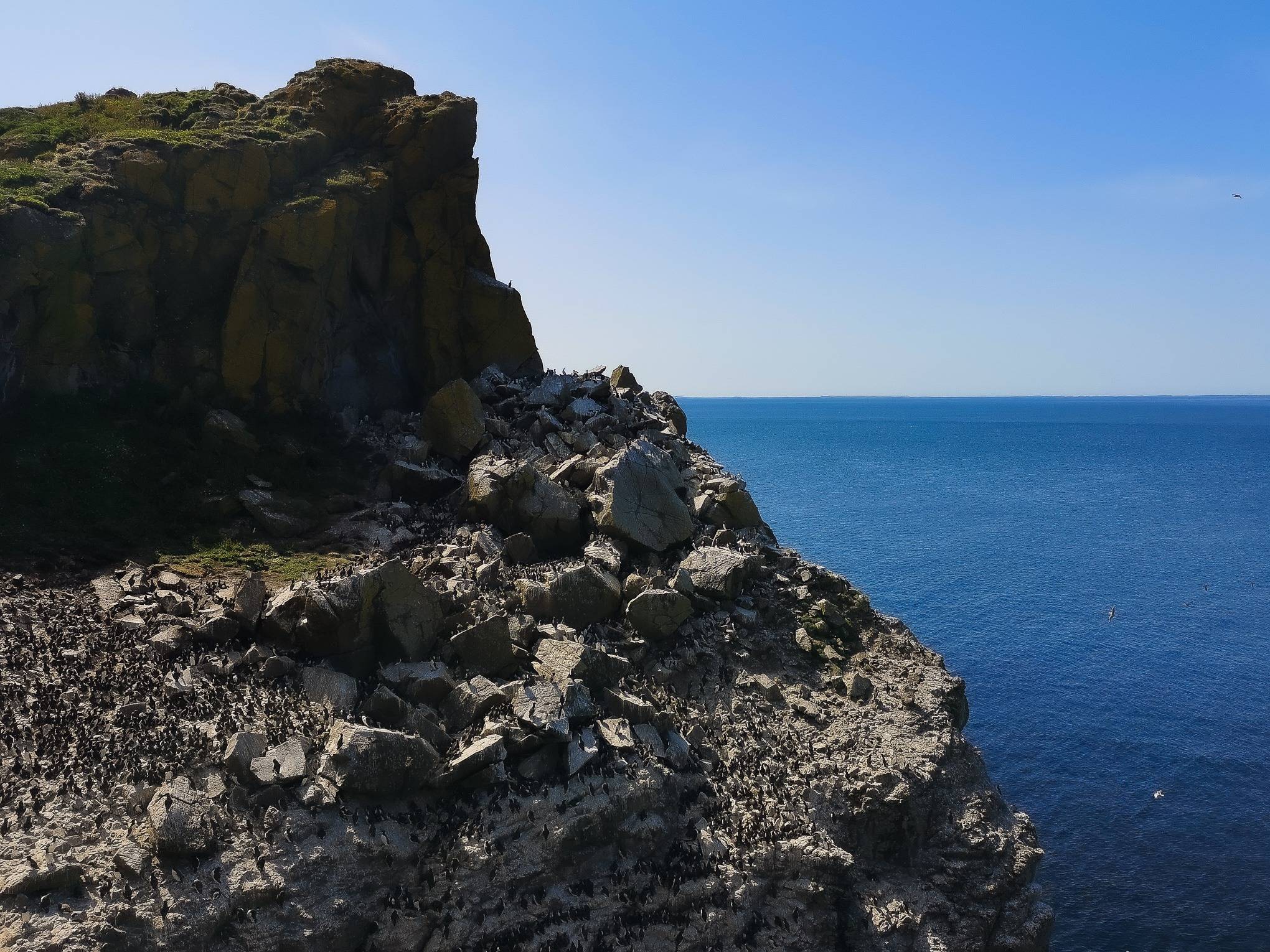
City of guillemots in Lunga Island, the Treshnish isles wildlife tour, Scotland. Photo by Alis Monte [CC BY-SA 4.0], via Connecting the Dots
Are Guillemots Penguins?
The first time I saw guillemots I had to spend quite a while trying to understand, who are these birds. At that time I haven’t heard of them and they look exactly like penguins. As the popular reasoning test goes – “If it looks like a duck, swims like a duck, and quacks like a duck, then it probably is a duck”. Despite guillemots positively passing this test, in reality, it can’t be a “duck”. Penguins live only around the Southern part of the globe. Still, being completely unrelated, they look alike. Both species probably followed the same evolutionary design for optimal swimming and diving. The main difference is the size and ability to fly. Guillemots are way smaller than penguins, which is hard to say from a great distance.

These birds live on the cliffs near the water, so it is not as easy to approach them like puffins or razorbills. Photo by Alis Monte [CC BY-SA 4.0], via Connecting the Dots
The City of Birds
Another interesting feature of these beautiful birds is the shape of their eggs, which look like a pear rather than a usual egg. The shape helps to stop the eggs from rolling off the narrow cliff ledges. Guillemots live and mate in the sea, so they inhabit the cliffs only during the breeding season. At that time, those cliffs become quite a sight to see. Without a doubt, I’ve never seen anything more similar to a city in the animal kingdom than this. Little “penguins” growing their children in a safe neighborhood on a beautiful island. Sounds like paradise, isn’t it?
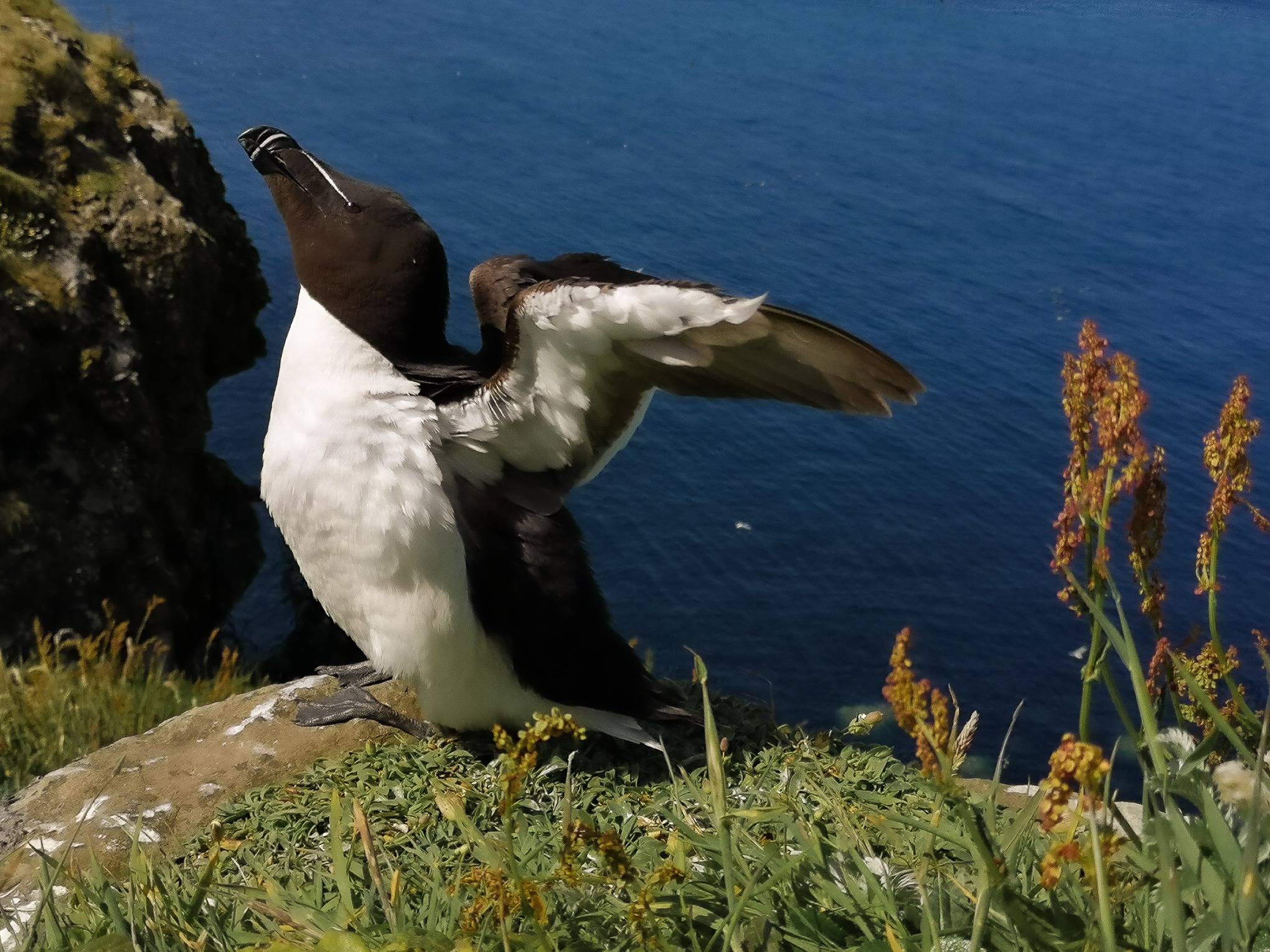
Razorbill stretching its wings on the Treshnish isles wildlife tour, Scotland. Photo by Alis Monte [CC BY-SA 4.0], via Connecting the Dots
Conservation of Bird Havens
Bird paradises like Lunga Island are getting harder and harder to find in the heavily civilized regions like Western Europe. I believe this beautiful island is only so because there are so many islands in Scotland. The preservation of this bird haven is up to us.
The whole wildlife tour to Lunga Island, and meeting with puffins, razorbills, and guillemots, is a good way to experience the thin barrier between humans and nature. It doesn’t matter if you are an enthusiast of birds, animals or nature in general, this place will be a pleasant surprise. If you decide to visit Lunga or any of the Treshnish Isles, be respectful. Environments like these are very fragile, especially, during the breeding season. If they are to remain open to the public, we, visitors, must be conscious of what we are doing. Those slightly better Instragam shots are just not worth the stress of a loving mother and her chick.
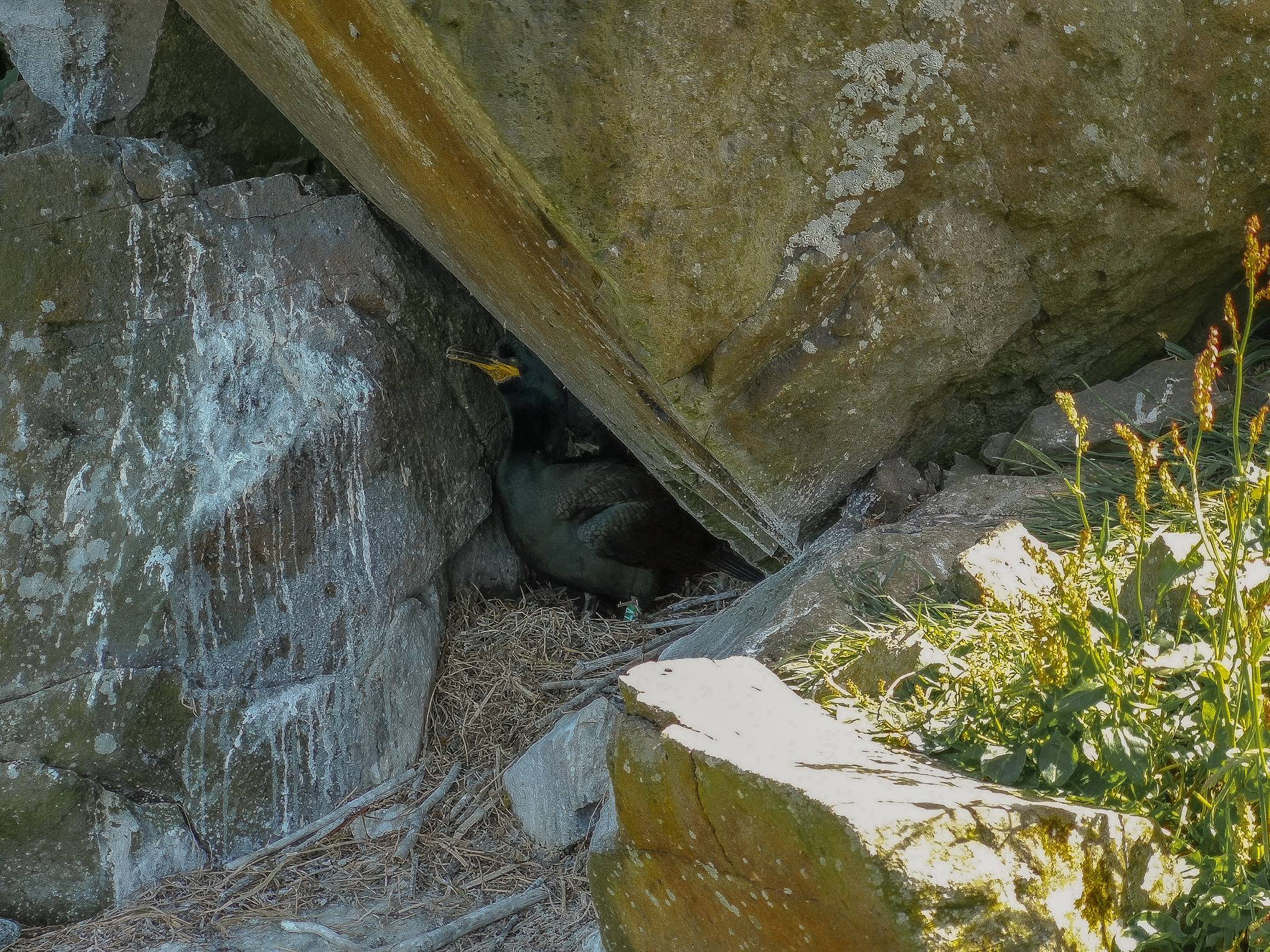
Cormorant protecting her chick, Lunga island, Scotland. Photo by Alis Monte [CC BY-SA 4.0], via Connecting the Dots
The good thing is that the Treshnish Isles and Lunga don’t seem to be touched by the “popular” tourism, filled with the mindless ghouls torturing the environment to get some extra likes on their social media page. Though I have to note that I saw some idiots, taking close-up shots of a desperate mother trying to protect her child. Don’t be one of them, take those shots from a distance. Unlike the more popular regions, on average, the people we met in Lunga Island and on the wildlife tour have shown way higher respect for nature.

Lone puffin watching the sea near a cliff on Lunga Island, Scotland. Photo by Alis Monte [CC BY-SA 4.0], via Connecting the Dots
Personal Experience
First, I was lucky on my trip to Lunga Island. The weather conditions were close to being perfect in Scotland that day, therefore together with puffins and other birds I got to enjoy the sun and some warm breeze. Second, at that moment I was not a birding enthusiast, thus I was not sure what to expect from it. Luckily, puffins look so cute that the idea of visiting them on Lunga Island seemed to be an attractive idea even to me. As a result, I was very surprised not only by the charismatic Atlantic “parrots” but their close relatives Razorbills and Guillemots, which look like an arctic species of penguins. All things considered, bird-watching in Lunga Island was the best time I had out of my couple visits to Scotland.
Is it worth to do Lunga Island Puffins Tour?
I feel like I’m talking the same points over and over again, but like many things, in Scotland, every experience depends on the weather and your tolerance to it. I wouldn’t suggest booking puffin tour tickets in front, but if the forecast for the day suits you, just come 40 minutes early and get them at the ferry administration office. Despite that, if the weather conditions are right, those two hours on Lunga Island together with Puffins, Razorbills, Guillemots and other birds, could be easily the highlight of your whole trip to Scotland.
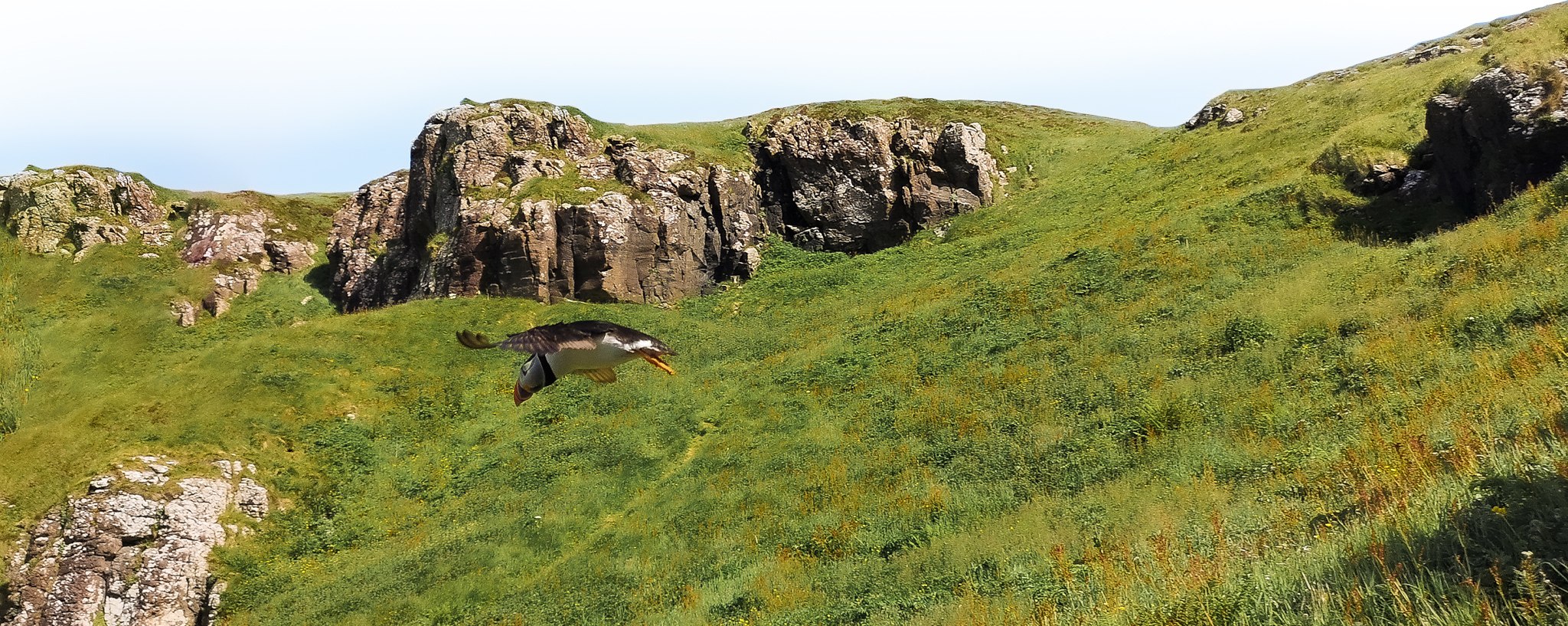
All content and photos by Alis Monte. If you want to collaborate, contact me on info@ctdots.eu Photo by Alis Monte [CC BY-SA 4.0], via Connecting the Dots